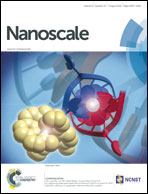Seed-assisted synthesis of Pd@Au core–shell nanotetrapods and their optical and catalytic properties†
Abstract
The synthesis of noble metal nanostructures with special morphology, structure, composition, and size has been an attractive research area because of their valuable applications in various fields, including optics, electronics, sensing and catalysis. In this work, the first Pd@Au core–shell nanotetrapods (Pd@Au CSNTPs) were synthesized through a facile seeded growth method. Specifically, Pd nanotetrapods were utilized as the substrate for Au coating through chemically reducing HAuCl4 with ascorbic acid (AA) in the presence of polyvinylpyrrolidone (PVP). The morphology, composition, and structure of Pd@Au CSNTPs were fully characterized by scanning and transmission electron microscopy, energy dispersive spectroscopy element mapping, X-ray powder diffraction, X-ray photoelectron spectroscopy techniques, etc. Different from conventional spherical Au nanoparticles, the Pd@Au CSNTPs had a very wide surface plasmon resonance (SPR) absorption band in the visible and near-infrared regions (500–1400 nm), showing special SPR absorption features. Meanwhile, the Pd@Au CSNTPs exhibited remarkably enhanced catalytic activity for the hydrogenation reduction of nitro functional groups and the C![[double bond, length as m-dash]](https://www.rsc.org/images/entities/char_e001.gif) N bond because of their specific structural characteristics.
N bond because of their specific structural characteristics.


 Please wait while we load your content...
Please wait while we load your content...